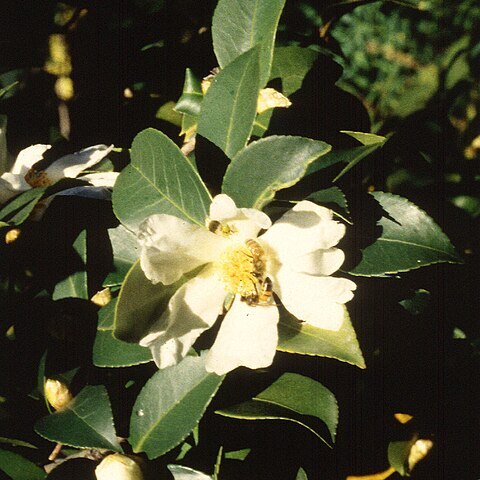Shrubs or trees, 1-5(-8) m tall. Young branches grayish brown; current year branchlets reddish brown, pubescent. Petiole 5-10 mm, pubescent; leaf blade elliptic, oblong-elliptic, or obovate, 3-10(-12) × 2-4(-5) cm, leathery to rigidly leathery, abaxially pale green, sparsely pilose along midvein or glabrous, and becoming yellowish green when dry, adaxially dark green, shiny, and hirtellous along midvein, midvein raised on both surfaces, secondary veins 5-8 on each side of midvein, abaxially obscure, and adaxially raised, base broadly cuneate to cuneate, margin serrate to serrulate, apex acute to acuminate and with an obtuse tip. Flowers axillary or subterminal, solitary or paired, 4-6 cm in diam., subsessile. Bracteoles and sepals 8-11, caducous; outer bracteoles and sepals lunate to semiorbicular, scalelike, 1-3 mm, glabrous or subglabrous; inner bracteoles and sepals obovate to suborbicular, 0.9-1.2 cm, outside yellow tomentose, inside glabrous, margin membranous and ciliolate. Petals 5-7, white, nearly distinct, obovate, oblong-obovate, or oblanceolate, 2.5-3.5(-4.5) × 1.5-2.5(-3) cm, apically 2-parted. Stamens ca. 1.5 cm, glabrous; outer filament whorl basally connate for ca. 5 mm. Ovary globose, 2-3 mm in diam., white tomentose, 3-loculed; style 0.8-1.2 cm, glabrous or base tomentose, apically 3-lobed to 3-parted. Capsule globose to ellipsoid, 2-4 cm in diam., 1-3-loculed with 1 or 2 seeds per locule; pericarp 3-6 mm thick, villous, splitting into 2 or 3 valves. Seeds brown to reddish brown, globose to semiglobose, 1.5-2 cm in diam. Fl. Dec-Jan, fr. Sep-Oct. 2n = 30, 45, 60, 90.
More
A shrub. In forests it can be a small tree. It grows 3-4 cm high. The young branches are hairy. New growth is bright yellow-green. The leaves are leathery and narrowly oblong. They are 3-5 cm long by 2-3 cm wide. The flower buds are pink and the flowers are white. The flowers usually occur singly in the axils near the ends of branches. The fruit are round capsules about 2 cm across.
Can be grown by cuttings or seedlings. Seeds needs soaking.


